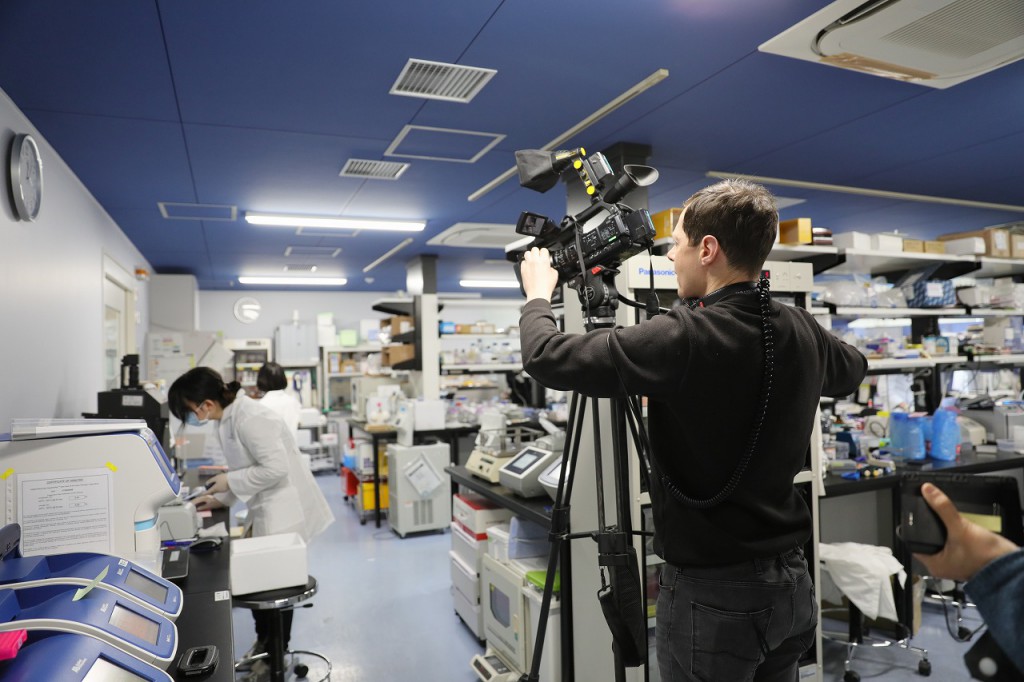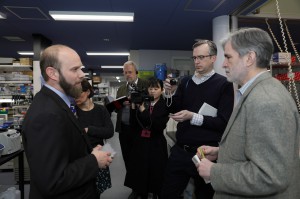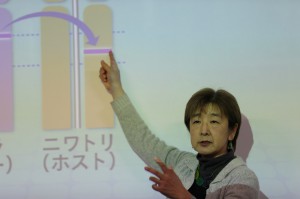実施日 : 2017年03月01日(水)
Report: Second Kyoto University Press Tour
投稿日 : 2017年04月03日
On Wednesday, March 1, the FPCJ held its second Kyoto university press tour in the past year.
The first tour was held in November 2016, and covered research into disaster prevention, a field Japan is a leader in due to the frequency of natural disasters in the country. This second press tour looked at iPS cells (induced pluripotent stem cells) and life science. A total of 13 journalists participated from 10 organizations, from China, Denmark, France, Germany, Hong Kong, South Korea, Taiwan, and the U.S.

Click here for further details on the tour.
Kyoto University Center for iPS Cell Research and Application (CiRA)

It is safe to say that iPS cells are among the most well-known cells in Japan. Kyoto University is home to the Center for iPS Cell Research and Application (CiRA), a research institute specializing in these cells. The director of CiRA is Professor Shinya Yamanaka, whose work is the reason iPS cells became so well known in Japan. With his receipt of the 2012 Nobel Prize in Physiology or Medicine, the professor immediately became a household name.

The press tour began with a visit to CiRA where a staff member gave a briefing, explaining how now, 10 years after the discovery of iPS cells, CiRA’s mission is to have medical applications of iPS cells by 2030. To succeed at this goal, the center is working on regenerative medicine, drug discovery, and pioneering new life science and medicine, with the goal of achieving the highest quality of medical support and research facilities in Japan.
Currently, CiRA is involved in using iPS cells for a variety of research. Dr. Knut Woltjen described his research into the mechanism for initializing cells with iPS cells, Dr. Hidetoshi Sakurai spoke about his work on muscular dystrophy, and Dr. Shin Kaneko explained his work on treating infections and cancer.

The journalists were also very interested in the tour provided of CiRA’s facilities. The center is built using an open lab concept, with no walls between labs and each floor a wide-open space. Guided by a CiRA science communicator, the group saw Dr. Woltjen and Dr. Sakurai’s research spaces and a variety of cutting-edge research equipment. There was also an opportunity for the journalists to use a microscope and see iPS cells for themselves, which they responded to with interest.
 There was also an interview with Professor Yamanaka, CiRA’s director.
There was also an interview with Professor Yamanaka, CiRA’s director.
Professor Yamanaka was formerly a clinical orthopedic surgeon, but after deciding “I want to help patients through research,” he discovered iPS cells, which could revolutionize medical science. According to the professor, “Clinical applications of iPS cells are progressing faster than I had imagined.” There may be new hope for previously untreatable diseases. Journalists from other Asian countries asked the professor how much presence researchers from their countries had in Japan.
Graduate School of Science

Next, the tour went and visited the lab of Professor Yoshiko Takahashi at the Graduate School of Science.
Over 30 years ago, Professor Takahashi was the first researcher in Japan to handle embryonic stem cells. She studied overseas in France, and has been a leading researcher for years as one of the first female Japanese researchers in the sciences. Research is often faced with the question of “How does this contribute to society,” and Professor Takahashi argued that the fundamental research being carried out at the Kyoto University Graduate School of Science was an important process forming the basis for all other research.
 Professor Takahashi is currently researching the mechanisms of cells. Her research is unique in how she is using chicken eggs to do so. By opening holes in the eggs, it is possible to observe the process of cell division. At her lab, the journalists were able to see how scissors were used to open a hole in the shell, black ink added to make it easier to see the cells, and then a microscope used to observe the cells. Looking through the microscope, it was indeed possible to see the heart beating through the small hole, and the journalists were noticeably impressed.
Professor Takahashi is currently researching the mechanisms of cells. Her research is unique in how she is using chicken eggs to do so. By opening holes in the eggs, it is possible to observe the process of cell division. At her lab, the journalists were able to see how scissors were used to open a hole in the shell, black ink added to make it easier to see the cells, and then a microscope used to observe the cells. Looking through the microscope, it was indeed possible to see the heart beating through the small hole, and the journalists were noticeably impressed.
Photos: Atsushi Shibuya
<News Reports by Participants>
新華社通信(中国)
「探访再生医疗最前沿」
客观日本(中国)
「探访京都大学iPS细胞研究所(上)」
「探访京都大学iPS细胞研究所(下)」
Scientific American(米国)
”Waiting to Reprogram Your Cells? Don't Hold Your Breath”
Science(米国)
”Cutting-edge stem cell therapy proves safe, but will it ever be effective?”
朝鮮日報(韓国)
「20년 불황에도 노벨상 17명 배출한 R&D, 첨단산업을 꽃피우다」



